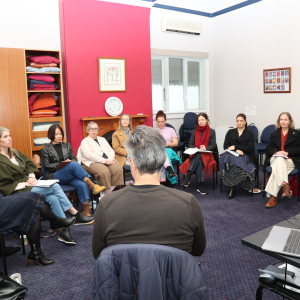The Power of Empty Chair Work in EFT (Australia)

The Power of Empty Chair Work in EFT: Healing Unmet Childhood Needs
Developed from the Gestalt Therapy tradition, Empty Chair work (also known as Empty Chair Work for Unfinished Business) is a cornerstone technique (‘task’) in Emotion Focused Therapy (EFT), enabling clients to confront unresolved emotional issues, particularly those stemming from unmet childhood needs (Elliot et al., 2004; Greenberg et al., 1993). In this evocative process, individuals “speak” to a significant other, such as a partner, parent – someone who hurt them or disappointed them in some way, by imagining them seated in an empty chair. This allows blocked emotions to surface, creating an opportunity for healing. This task offers a safe space for clients to express painful emotions, such as anger, grief, or sadness, that are tied to past trauma, abandonment, or neglect.
Exploring Unfinished Business
 At the heart of empty chair work is the concept of “unfinished business” – the unresolved emotional experiences or conflicts from the past that continue to influence a person’s emotional well-being. These unresolved emotions often arise from childhood experiences where fundamental needs for love, emotional validation, or safety went unmet. This creates deep-rooted emotional patterns that affect adult relationships and reactions to stress (Greenberg, 2015). Unfinished business is not always easy to process, and therapists play a crucial role in guiding clients through intense emotions, ensuring that the process remains grounded and therapeutic (Paivio & Pascual-Leone, 2010;Watson, 2019).
At the heart of empty chair work is the concept of “unfinished business” – the unresolved emotional experiences or conflicts from the past that continue to influence a person’s emotional well-being. These unresolved emotions often arise from childhood experiences where fundamental needs for love, emotional validation, or safety went unmet. This creates deep-rooted emotional patterns that affect adult relationships and reactions to stress (Greenberg, 2015). Unfinished business is not always easy to process, and therapists play a crucial role in guiding clients through intense emotions, ensuring that the process remains grounded and therapeutic (Paivio & Pascual-Leone, 2010;Watson, 2019).
The Role of Empathy in Empty Chair Work

The therapeutic relationship is central to the effectiveness of empty chair work, particularly the therapist’s ability to be empathetically attuned to the client’s emotional experience (Watson, 2019). A compassionate and empathic presence allows clients to safely explore deep, vulnerable emotions such as shame, guilt, or anger related to their past.
By reflecting on these emotions in a non-judgmental and validating way, therapists help clients shift their emotional perspective and access new layers of healing (Watson, 2019). Empathy also helps the therapist keep the emotional experience on track, ensuring that clients don’t become overwhelmed or disengaged.
Challenges and Opportunities in Empty Chair Work
 One of the challenges with empty chair work is when clients attempt to avoid the full emotional experience. This may manifest as intellectualising the situation or emotionally distancing themselves. This avoidance is often a protective mechanism developed over years of emotional distress. Emotion-focused therapists do not push clients to engage with the task but instead gently encourage clients to engage with their feelings in whatever ways feel safe at the time (Elliot et al., 2004; Elliott & Greenberg, 2021; Paivio & Pascual-Leone, 2010).
One of the challenges with empty chair work is when clients attempt to avoid the full emotional experience. This may manifest as intellectualising the situation or emotionally distancing themselves. This avoidance is often a protective mechanism developed over years of emotional distress. Emotion-focused therapists do not push clients to engage with the task but instead gently encourage clients to engage with their feelings in whatever ways feel safe at the time (Elliot et al., 2004; Elliott & Greenberg, 2021; Paivio & Pascual-Leone, 2010).
When successful, empty chair work can lead to profound emotional breakthroughs, allowing clients to process and transform past pain. This emotional processing opens the door to greater self-acceptance, healthier relationships, and more adaptive emotional responses to stress (Elliot et al., 2004; Greenberg et al., 1993).
How Unfinished Business Gets Off Track – and How to Bring It Back
 While empty chair work is generally a straightforward process, it is not always linear. At times, clients can get “stuck”, unable to move forward with the emotional work. This may occur when intense feelings become overwhelming or when clients fall into repetitive cycles without reaching resolution. A skilled therapist is crucial in recognising when this happens and helping clients return to the therapeutic goal. For instance, revisiting the empty chair exercise with a different emotional perspective or reframing the person or event being addressed can offer new insights and allow for emotional movement (Elliott & Greenberg, 2021).
While empty chair work is generally a straightforward process, it is not always linear. At times, clients can get “stuck”, unable to move forward with the emotional work. This may occur when intense feelings become overwhelming or when clients fall into repetitive cycles without reaching resolution. A skilled therapist is crucial in recognising when this happens and helping clients return to the therapeutic goal. For instance, revisiting the empty chair exercise with a different emotional perspective or reframing the person or event being addressed can offer new insights and allow for emotional movement (Elliott & Greenberg, 2021).
Deepening EFT Practice with Barry Strmelj’s Workshop
 Empty chair work is a powerful and transformative tool for emotional healing, especially for clients dealing with unresolved childhood experiences. While it offers immense potential for change, it requires a careful, empathetic, and skilled approach to facilitate effectively.
Empty chair work is a powerful and transformative tool for emotional healing, especially for clients dealing with unresolved childhood experiences. While it offers immense potential for change, it requires a careful, empathetic, and skilled approach to facilitate effectively.
For practitioners looking to hone their skills in empty chair work, Barry Strmelj’s upcoming workshop, “Essential Skills for Empty Chair Work: Creating Change Through Healing Old Wounds,” offers a valuable opportunity to explore the key elements of this technique. The workshop will be held at the AIEFT in South Yarra, Melbourne this coming May and will provide experiential exercises, demonstrations, and opportunities to reflect on one’s practice. This is a great opportunity for practitioners to explore this skill, refine their skills and approach, or enhance their confidence when working with clients in this important area of emotional healing. You can find out more about this workshop and deepening your skills with empty chair work here.
Find out more about what Emotion-Focused Therapy is here.
References
Elliott, R., & Greenberg, L. (2021). Emotion-focused counselling in action. Sage.
Elliott, R., Watson, J. C., Goldman, R. N., & Greenberg, L. S. (2004). Learning emotion-focused therapy: The process-experiential approach to change. American Psychological Association.
Greenberg, L. S. (2015). Emotion-focused therapy coaching clients to work through their feelings (2nd ed.). American Psychological Association.
Greenberg, L. S., Rice, L. N., & Elliott, R. (1993). Facilitating emotional change: the moment-by-moment process. Guilford Press.
Greenberg, L. S. (2015). Emotion-focused therapy coaching clients to work through their feelings (2nd ed.). American Psychological Association.
Paivio, S. C., Pascual-Leone, A., & American Psychological Association. (2010). Emotion-focused therapy for complex trauma an integrative approach (1st ed.). American Psychological Association.
Watson, J. (2019). Role of the therapeutic relationship in emotion-focused therapy. In L. S. Greenberg & R. N. Goldman (Eds.), Clinical handbook of emotion-focused therapy (First edition. ed.). American Psychological Association.
Keywords: EFT techniques Australia, empty chair technique, childhood trauma therapy EFT




